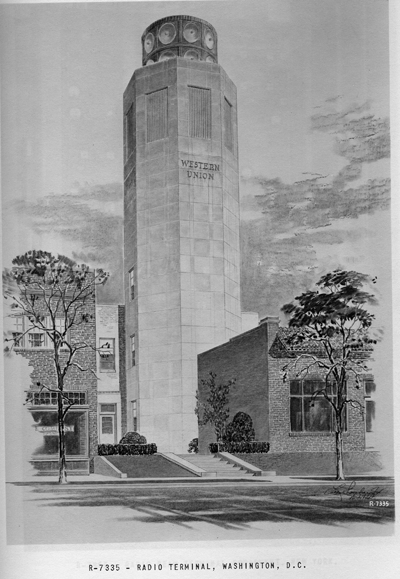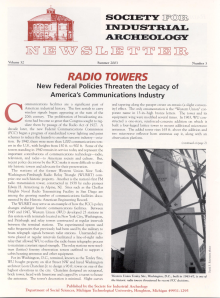There’s new controversy heating up in Tenleytown at the site where a telecommunications tower company aborted construction of a 765 756-foot broadcast tower that would have loomed over a historic landmark and the Tenleytown neighborhood.
In 2000 American Tower Corporation began construction of a 765 756-foot broadcast tower in Washington, D.C.’s Tenleytown neighborhood. The proposed tower site coincidentally happened to be the D.C. terminal for the nation’s first private-sector microwave network. Built by the Western Union Telegraph Company after the end of World War II, the former Tenley site was determined eligible for listing in the National Register of Historic Places and designated as a District of Columbia historic Landmark. After a prolonged legal battle that included revocation of its building permit, in 2006 American Tower began dismantling the partly built tower.
To prepare its site for the massive lattice tower base, American Tower needed more space and it acquired a perpetual easement in 1998 from the Washington Gas Light Company, which owned a neighboring lot. The contract executed by American Tower and Washington Gas granted American Tower “a perpetual easement … for the purposes of removing the existing building on the Washington Gas Property and constructing a tower for communication purposes.”

Western Union Telegraph Company rendering of the proposed Tenley terminal site. Drawn by Washington architect Leon Chatelain, the former Washington Gas building is visible to the right of the future Western Union building.
American Tower never fulfilled its obligations as a Federal Communications Commission licensee to identify historic properties and assess the effects of its actions to those properties prior to demolishing the former Washington Gas building and adversely affecting the landmark Western Union building. According to American Tower, the company did not have to comply with Section 106 of the National Historic Preservation Act (NHPA) at the Tenley site because the property already had a telecommunications facility. I wrote about the Western Union network in several journal and newsletter articles published between 2003 and 2008. I also used the Tenley site as an example of how the FCC’s National Historic Preservation Act compliance program was failing the telecom and broadcast industries, historic preservation, and the public. The telecom industry was not pleased with my research. During a 2005 House of Representatives subcommittee hearing on the National Historic Preservation Act, my work was mentioned by a telecom industry lobbyist and by Representative Devin Nunes (R-Calif.). I recorded the hearing and incorporated it into this YouTube video. The video also has early footage of Western Union’s Tenley terminal:
In 2002 I filed a complaint with the FCC, the Advisory Council on Historic Preservation, and the District of Columbia Historic Preservation Office advising them that American Tower had begun construction of the new broadcast tower in violation of the National Historic Preservation Act and National Environmental Policy Act (NEPA). Part of my complaint included the anticipatory demolition of the Washington Gas building:
In addition to foreclosing on the Advisory Council’s opportunity to comment on the construction of the proposed 756-foot broadcast tower resulting in the adverse effect to the Western Union Telegraph Company Tenley Site, American Tower Corporation also demolished a historic property in advance of construction of the 756-foot tower. According to an instrument (“Easement Agreement”) filed with the District of Columbia Register of Deeds 17 December 1998, American Tower Corporation acquired an easement from the Washington Gas Light Company granting American Tower the right to construct its tower over a portion of the Washington Gas property (Attachment B). According to the easement agreement, Washington Gas granted American Tower Corporation “a perpetual easement … for the purposes of removing the existing building on the Washington Gas property and constructing a tower for communications purposes.”
The Washington Gas building was a one-story brick commercial block used by the company as a radio booster station. The Washington Gas building has supported a guyed communications tower on its roof since at least March 1952. The building and tower were used “to support radio antenna used to communicate with mobile units in company cars and trucks.”[1] Like the Western Union Telegraph Company, Washington Gas took advantage of the District’s highest elevation for use as a historic communications facility. Sanborn Map Company fire insurance maps show the former Washington Gas building at the site since at least 1927 (Attachment C).
Section 110(k) of the National Historic Preservation Act (16 U.S.C. 470h-2(k)) appears to apply to American Tower Corporation’s undertakings at the historic former Western Union Tenley Site. These actions include the demolition of the former Washington Gas Light Company building and construction of the partially completed 756-foot broadcast tower at the former Western Union Tenley Site, adversely affecting the Western Union transmission tower.
The D.C. Historic Preservation Office never addressed the anticipatory demolition complaint and the FCC closed its file, finding that American Tower did nothing wrong. Today the DCmud blog posted an article on proposed new development at the former Washington Gas building site and Tenleytown residents are burning up the email wondering how this could have happened. I suspect that had the FCC, Advisory Council on Historic Preservation, and the DC Historic Preservation Office followed through on American Tower’s failure to comply with NHPA and NEPA, things may be a little different. I don’t really have an opinion on the proposed new building other than the community would have had more input into whatever went there if FCC, DC HPO, et al., had done their jobs differently and worked out a mitigation plan — which ideally would have included stakeholder consultation — for whatever was built to replace the unlawfully demolished Washington Gas building.
[1] Information provided in a District of Columbia building permit issued to the Washington Gas Light Company 5 January 1955. Building Permit No. A-62174.
Shortlink for this post: https://wp.me/s1bnGQ-tenley2




So, exactly what battle is looming? You say FCC and HPO closed their files. On what grounds could this development be opposed?
That’s up to the stakeholders. All I know is there was a flurry of emails directed at the DC HPO by local preservation advocates. How they approach things is really up to them. I’m not an attorney, so I don’t know what remedies interested parties might have in a NEPA and NHPA issue more than a decade old. If I lived in the District of Columbia I would want to know why the Historic Preservation Office ignored the anticipatory demolition issue detailed in the 2002 complaint against American Tower Corporation.
Great insights on Tenley Tower II and its historic preservation challenges! Wireless Equity Group could enhance community value by considering a perpetual easement, ensuring long-term wireless access without compromising heritage.